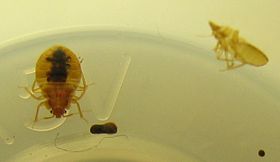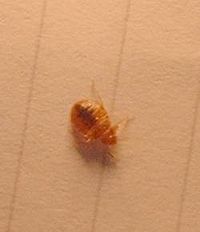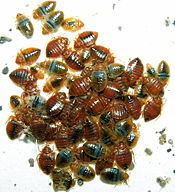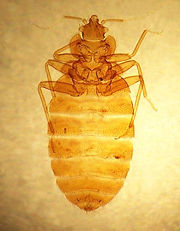Bedbug
2008/9 Schools Wikipedia Selection. Related subjects: Insects, Reptiles and Fish
| Bedbug | ||||||||||||
|---|---|---|---|---|---|---|---|---|---|---|---|---|
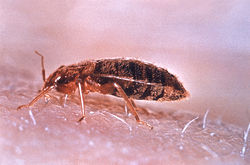 Cimex lectularius
|
||||||||||||
| Scientific classification | ||||||||||||
|
||||||||||||
| Genera & Species | ||||||||||||
|
Genus Cimex
Genus Leptocimex
Genus Haematosiphon
Genus Oeciacus
Genus Afrocimex
|
A bedbug (or bed bug) is a small nocturnal insect of the family Cimicidae that lives by hematophagy, or by feeding on the blood of humans and other warm-blooded hosts.
Biology
The common bedbug (Cimex lectularius) is the best adapted to human environments. It is found in temperate climates throughout the world and feasts on the blood of humans. Other species include Cimex hemipterus, found in tropical regions (as well as Florida), which also infests poultry and bats, and Leptocimex boueti, found in the tropics of West Africa and South America, which infests bats and humans. Cimex pilosellus and Cimex pipistrella primarily infest bats, while Haematosiphon inodora, a species of North America, primarily infests poultry.
Oeciacus, while not strictly a bedbug, is a closely related genus primarily affecting birds.
Adult bedbugs are a reddish brown, flattened, oval, and wingless, with microscopic hairs that give them a banded appearance. A common misconception is that they are not visible to the naked eye. Adults grow to 4 to 5 mm (one-eighth to three-sixteenths of an inch) in length and do not move quickly enough to escape the notice of an attentive observer. Newly hatched nymphs are translucent, lighter in colour and continue to become browner and moult as they reach maturity. When it comes to size, they are often compared to lentils or appleseeds.
A recent paper by Professor Brian J. Ford and Dr Debbie Stokes gives views of a bedbug under various microscopes.
Feeding habits
Bedbugs are generally active only at dawn, with a peak attack period about an hour before sunrise. They may attempt to feed at other times, however, given the opportunity, and have been observed to feed at any time of the day. Attracted by warmth and the presence of carbon dioxide, the bug pierces the skin of its host with two hollow tubes. With one tube it injects its saliva, which contains anticoagulants and anesthetics, while with the other it withdraws the blood of its host. After feeding for about five minutes, the bug returns to its hiding place. The bites cannot usually be felt until some minutes or hours later, as a dermatological reaction to the injected agents, and the first inclination of a bite usually comes from the desire to scratch the bite site.
Although bedbugs can live for a year or as much as 18 months without feeding, they typically seek blood every five to ten days. Bedbugs that go dormant for lack of food often live longer than a year, well-fed specimens typically live six to nine months. Low infestations may be difficult to detect, and it is not unusual for the victim not to even realize they have bedbugs early on. Patterns of bites in a row or a cluster are typical as they may be disturbed while feeding. Bites may be found in a variety of places on the body.
Bedbugs may be erroneously associated with filth in the mistaken notion that this attracts them. However, severe infestations are often associated with poor housekeeping and clutter. Bedbugs are attracted by exhaled carbon dioxide and body heat, not by dirt, and they feed on blood, not waste. In short, the cleanliness of their environments has effect on the control of bedbugs but, unlike cockroaches, does not have a direct effect on bedbugs as they feed on their hosts and not on waste. Good housekeeping in association with proper preparation and mechanical removal by vacuuming will certainly assist in control.
Reproduction
All bedbugs mate via a process termed traumatic insemination. Instead of inserting their genitalia into the female's reproductive tract as is typical in copulation, males instead pierce females with hypodermic genitalia and ejaculate into the body cavity. This form of mating is thought to have evolved as a way for males to overcome female mating resistance. Traumatic insemination imposes a cost on females in terms of physical damage and increased risk of infection. To reduce these costs females have evolved internal and external "paragenital" structures collectively known as the “spermalege”. Within the True Bugs (Heteroptera) traumatic insemination occurs in the Prostemmatinae (Nabidae) and the Cimicoidea (Anthocoridae, Plokiophilidae, Lyctocoridae, Polyctenidae and Cimicidae), and has recently been discovered in the plant bug genus Coridromius (Miridae).
Remarkably, in the genus Afrocimex both males and females possess functional external paragenitalia, and males have been found with copulatory scars and the ejaculate of other males in their haemolymph. There is a widespread misbelief that males inseminated by other males will in turn pass the sperm of both themselves and their assailants onto females with whom they mate. While it is true that males are known to mate with and inject sperm into other males, there is however no evidence to suggest that this sperm ever fertilizes females inseminated by the victims of such acts.
Young
Female bedbugs can lay up to five eggs in a day and 500 during a lifetime. The eggs are visible to the naked eye measuring 1 mm in length (approx. two grains of salt) and are a milky-white tone. The eggs hatch in one to two weeks. The hatchlings begin feeding immediately. They pass through five molting stages before they reach maturity. They must feed once during each of these stages.
At room temperature, it takes about five weeks for a bedbug to pass from hatching to maturity. They become reproductively active only at maturity.
Bites
In most observed cases a small, hard, swollen, white welt may develop at the site of each bedbug bite. This is often surrounded by a slightly raised red bump and is usually accompanied by severe itching that lasts for several hours to days. Welts do not have a red spot in the centre such as is characteristic of flea bites. In other cases, it is observed that welts first appear upon the inccessant scratching that is triggered by the bite, and seem like a mosquito bite that increases in size upon scratching. Later, however, the welts subside but tend not to disappear like those from mosquitos, and persist for up to several weeks. This usually depends on the person's skin type, environment and the species of bug.
Some individuals respond to bed bug infestations and their bites with anxiety, stress, and insomnia. Individuals may also get skin infections and scars from scratching the bedbug bite locations.
Most patients who are placed on systemic corticosteroids to treat the itching and burning often associated with bed bug bites find that the lesions are poorly responsive to this method of treatment. Antihistamines have been found to reduce itching in some cases, but they do not affect the appearance and duration of the lesions. Topical corticosteroids, such as hydrocortisone, have been reported to expediently resolve the lesions and decrease the associated itching.
Disease transmission
Bed bugs seem to possess all of the necessary prerequisites for being capable of passing diseases from one host to another, but there have been no known cases of bed bugs passing disease from host to host. There are at least twenty-seven known pathogens (some estimates are as high as forty-one) that are capable of living inside a bed bug or on its mouthparts. Extensive testing has been done in laboratory settings that also conclude that bed bugs are unlikely to pass disease from one person to another. Therefore bedbugs are less dangerous than some more common insects such as the flea. However, transmission of trypanosomiasis ( Chagas disease) or hepatitis B might be possible in appropriate settings.
The salivary fluid injected by bed bugs typically causes the skin to become irritated and inflamed, although individuals can differ in their sensitivity. Anaphylactoid reactions produced by the injection of serum and other nonspecific proteins are observed and there is the possibility that the saliva of the bedbugs may cause anaphylactic shock in a small percentage of people. It is also possible that sustained feeding by bedbugs may lead to anaemia. It is also important to watch for and treat any secondary bacterial infection.
History
Bedbugs were originally brought to the United States by the early colonists. They thrive in places with high occupancies such as hotels. Bedbugs were believed to be altogether eradicated 50 years ago in the United States and elsewhere with the widespread use of DDT. Some theories are now suggesting that they never really left. One recent theory about the reappearance of bedbugs has to deal with geographic epicenters where the bedbugs are believed to centre from. During the investigations of these epicenters, they found two locations where they discovered the apparent epicenters. They are located at poultry facilities in Arkansas and Texas. It was determined that the workers in these facilities were the main spreaders of these bedbugs and carrying them to their places of residence and elsewhere after leaving work.Bedbug populations in the United States have increased by 500 percent in the past few years. It is still uncertain exactly what has caused the resurgence of these bedbugs, but most believe it has to do with the increase in international travel and the use of new pest-control methods that do not affect bedbugs. In the last few years, the use of baits instead of insecticide sprays is believed to have contributed to the increase.
Resurgence of bedbug infestations
As previously stated, bedbugs were all but eradicated from North America during the 1940s and 50s. However, bedbug cases have been on the rise recently, not only in North America, but all across the world. Prior to the mid twentieth century, bed bugs were very common. According to a report by the UK Ministry of Health, in 1933 there were many areas where all the houses were infested with bedbugs to an extent. Since the mid 90's, the reports of bed bug cases have been on the rise. Figures from one London borough show the numbers of reported bedbug infestations doubling each year during the period from 1995 to 2001. The rise in bedbug infestations has been hard to track due to the fact that bedbugs are not an easily identifiable problem. Most of the reports are collected from various pest-control companies, local authorities, and hotel chains. Therefore, the problem may be more severe than we currently believe it to be. Several reasons have been noted for the cause of the recent bedbug resurgence but the main two are the recent increase in international travel and the use of less noxious pesticides.
The most-cited reason for the dramatic rise in bed bug cases world wide is due to the increase in international travel in recent decades. In 1999, four separate infestations throughout the United Kingdom alerted people to the possibility of an increase in the world wide bedbug population, facilitated by international travel and trade. However, there is evidence of a previous cycle of bed bug infestations in the United Kingdom. The Institution of Environmental Health Officers maintained statistics for bed bug infestations, data collected from reports and inspections. In the period 1985-1986, the Institution of Environmental Health Officers reported treating 7,771 infestations in England and Wales, and 6,179 infestations in 1986-1987. There were also reports of infestations in Belfast and Scotland.
New York City has been riddled with bedbug infestations since the turn of the century. Bedbugs have found their ways into hotels, schools, and even hospital maternity wards. Jeffrey Eisenberg, the owner of Pest Away Exterminating on the Upper West Side claims his company receives 125 calls a week now as compared to only a few just 5 years ago. In 2004, New York City had 377 bedbug violations. However, from July to November of 2005, a 5-month span, there were 449 violations reported in the city, an alarming increase in infestations over a short period of time. A large number of international travelers visit New York each day, and exterminators and entomology experts place most of the blame on them.
Since 1999, infestations have been reported in the United Kingdom, Germany, Spain, Australia, Canada, and the United States. Two separate studies in Tuscany, Italy provide further proof of the resurgence of bedbugs in relation with international travel. In case 1, during the summer of 2003 a seven year old boy developed a number of papulae on his lower legs which caused severe itching. His parents suspected insects in the boy’s room and upon searching found several in the folds of the mattresses on the young boy’s bed. Two specimens were identified as C. lectularius and the room was treated with an insecticide to rid the room of the bedbug infestation. The house the boy was living in had not experienced a bedbug infestation before. However, one month before the infestation, two family friends had traveled by plane from Nepal to stay with the family for ten days. This is a good indication for the transfer of bedbugs due to international travel. Case 2 involves a forty-eight year old man traveling by car to Pisa, Italy from Prague, Czech Republic in June of 2003 and staying in a rented house with three friends. After several days, the man noticed several bullous eruptions on his upper and lower extremities all arranged in linear clusters of three. The man found several insects in his room and after identification the insects were identified as C. lectularius. The rent house was well kept and had never had a bedbug infestation. However, a group of Germans had rented the house a few weeks before the Czech group arrived. This too was a good indicator of bedbug spread by international travel.
Due to the widespread use of potent insecticides such as DDT, bedbugs were nearly eradicated. However, many of these strong insecticides have been banned from use in the United States are being replaced with weaker insecticides such as pyrethroids. The problem with the weaker insecticides is that many bedbugs have grown resistant to them. A study at the University of Kentucky randomly collected bedbugs from across the entire United States. These “wild” bedbugs were up to several thousands of times more resistant to pyrethroids than the laboratory bedbugs. Another problem with current insecticide use is that the broad-spectrum insecticide sprays for cockroach and ants that are no longer used had a collateral impact on bedbug infestations. Recently, the switch has been made to bait insecticides which have proven effective for cockroaches but have allowed bedbugs to escape the indirect treatment.
The number of bedbug infestations have risen significantly since the turn of the century. The National Pest Management Association reported a 71% increase in bedbug calls between 2000 and 2005. The Steritech Group, a pest management company out of Charlotte, North Carolina, claimed that 25% of the 700 hotels they surveyed between 2002 and 2006 needed bedbug treatment. In 2003, a brother and sister staying at a Motel 6 in Chicago were awarded $372,000 in punitive damages after being attacked by bedbugs during their stay. These are only a few of the reported cases since the turn of the 21st century.
Infestations
There are several means by which dwellings can become infested with bedbugs. People can often acquire bedbugs at hotels, motels, and bed-and-breakfasts, as a result of increased domestic and international tourism, and bring them back to their homes in their luggage. They also can pick them up by inadvertently bringing infested furniture or used clothing to their household. If someone is in a place that is severely infested, bedbugs may actually crawl onto and be carried by people's clothing, although this is atypical behaviour — except in the case of severe infestations, bedbugs are not usually carried from place to place by people on clothing they are currently wearing. Finally, bedbugs may travel between units in multi-unit dwellings (such as condominiums and apartment buildings), after being originally brought into the building by one of the above routes. This spread between units is dependent in part on the degree of infestation, on the material used to partition units (concrete is a more effective barrier to the spread of the infestation), and whether infested items are dragged through common areas while being disposed of, resulting in the shedding of bedbugs and bedbug eggs while being dragged. In some exceptional cases, the detection of bedbug hiding places can be aided by the use of dogs that have been trained to signal finding the insects by their scent much as dogs are trained to find drugs or explosives. A trained team (dog and handler) can detect and pinpoint a bedbug infestation within minutes. This is a fairly costly service that is not used in the majority of cases, but can be very useful in difficult cases.
The numerical size of a bedbug infestation is to some degree variable, as it is a function of the elapsed time from the initial infestation. With regards to the elapsed time from the initial infestation, even a single female bedbug brought into a home has a potential for reproduction, with its resulting offspring then breeding, resulting in a geometric progression of population expansion if control is not undertaken. Sometimes people are not aware of the insects, and do not notice the bites. The visible bedbug infestation does not represent the infestation as a whole, as there may be infestations elsewhere in a home. However, the insects do have a tendency to stay close to their hosts (hence the name "bed" bugs).
Common location of infestations
Bedbugs travel easily and quickly along pipes and boards, and their bodies are very flat, which allows them to hide in tiny crevices. In the daytime, they tend to stay out of the light, preferring to remain hidden in such places as mattress seams, mattress interiors, bed frames, nearby furniture, carpeting, baseboards, inner walls, tiny wood holes, or bedroom clutter. Bedbugs can be found on their own, but more often congregate in groups. Bedbugs are capable of travelling as far as 100 feet to feed, but usually remain close to the host in bedrooms or on sofas where people may sleep.
Detection
Bedbugs are known for being elusive, transient, and nocturnal, making them difficult to detect. While individuals have the option of contacting a pest control professional to determine if a bedbug infestation exists, there are several do-it-yourself methods that may work equally well.
The presence of bedbugs may be confirmed through identification of the insects collected or by a pattern of bites. Though bites can occur singularly, they often follow a distinctive linear pattern marking the paths of blood vessels running close to the surface of the skin. The common bite pattern of three bites close to each other has garnered the macabre coloquialism "breakfast, lunch, dinner."
A technique for catching bedbugs in the act is to have a light source accessible from bed and to turn it on at about an hour before dawn, which is usually the time when bedbugs are most active. A flashlight is recommended instead of room lights, as the act of getting out of bed will cause any bedbugs present to scatter. If you awaken during the night, leave your lights off but use your flashlight to inspect your mattress. Bedbugs are fairly fast in their movements, about equal to the speed of ants. They may be slowed down if engorged.
Glue traps placed in strategic areas around the home, (sometimes used in conjunction with heating pads, or balloons filled with exhaled breath, thus offering the carbon dioxide that bedbugs look for) may be used to trap and thus detect bedbugs. This method has varied reports of success. There are also commercial traps like "flea" traps whose effectiveness is questionable except perhaps as a means of detection. Perhaps the easiest trapping method is to place double-sided carpet tape in long strips near or around the bed and check the strips after a day or more.
Controlling infestations
With the widespread use of DDT in the 1940s and '50s, bedbugs all but disappeared from North America in the mid-twentieth century. Infestations remained common in many other parts of the world, however, and in recent years have begun to rebound in North America. Reappearance of bedbugs in North America has presented new challenges for pest control without DDT and similarly banned agents.
Another reason for their increase is that pest control services more often nowadays use low toxicity gel-based pesticides for control of cockroaches, the most common pest in structures, instead of residual sprays. When residual sprays meant to kill other insects were commonly being used, they resulted in a collateral insecticidal effect on potential bedbug infestations; the gel-based insecticides primarily used nowadays do not have any effect on bedbugs, as they are incapable of feeding on these baits.
The National Pest Management Association, a US advocacy group for pest management professionals (PMPs) conducted a "proactive bed bug public relations campaign" in 2005 and 2006, resulting in increased media coverage of bedbug stories and an increase in business for PCOs, possibly distorting the scale of the increase in bedbug infestations.
If it is necessary to live with bedbugs in the short term, it is possible to create makeshift temporary barriers around a bed. Although bedbugs cannot fly or jump, they have been observed climbing a higher surface in order to then fall to a lower one, such as climbing a wall in order to fall onto a bed. That having been said, barrier strategies nevertheless often have beneficial effects: an elevated bed, for example, can be protected by applying double-sided sticky tape (carpet tape) around each leg, or by keeping each leg on a plastic furniture block in a tray of water. Bed frames can be effectively rid of adult bedbugs and eggs by use of steam or, used with caution, by spraying rubbing alcohol on any visible bugs (although this is not a permanent treatment). Small steam cleaners are available and are very effective for this local treatment. A suspect mattress can be protected by wrapping it in a painter's disposable plastic drop cloth, neatly sealing shut all the seams with packing tape, and putting it on a protected bed after a final visual inspection. Bedding can be sanitized by a 120 °F (49 °C) laundry dryer. Once sanitized, bedding should not be allowed to drape to the floor. An effective way to quarantine a protected bed is to store sanitized sleeping clothes in the bed during the day, and bathing before entering the bed.
Food-grade diatomaceous earth (DE) can be sprinked under mattresses, along baseboards and on the edges of bookshelves where bed bugs hide. Food-grade DE, although harmless to mammals, including common house pets and humans, is a virtual death sentence for bed bugs. DE is a drying agent and is actually used in many dry pet foods to keep the kibble dry and fresh.
The DE particles abrade the bed bug, essentially dehydrating it of water and lipids. DE can be purchased online, in some health food stores, and in most plant stores. Neem oil (mentioned below) can be added to the DE (1 cup DE to 20 drops neem oil) in a plastic bag before sprinking it around. Other essential oils that can be added are juniper oil, eucalyptus oil, jlang jlang oil, rosemary oil and tea tree oil. The bed bugs hate the smell of the oils, and for those who don't and pass through, they will eventually be killed by the DE itself. Use 20 drops of each essential oil mentioned for each cup of DE.
Alternative treatments that may actually work better and be more comfortable than wrapping bedding in plastic that would cause sweating would be to encase your mattress and box springs in impermeable bed bug bite proof encasements after a treatment for an infestation. There are many products on the market but only some products have been laboratory tested to be bed bug bite proof. Make sure to check to see that the product you are considering is more than an allergy encasement, but is bed bug bite proof.
Vermin and pets may complicate a barrier strategy. Bedbugs prefer human hosts, but will resort to other warm-blooded hosts if humans are not available, and some species can live up to eighteen months without feeding at all. A co-infestation of mice can provide an auxiliary food source to keep bedbugs established for longer. Likewise, a house cat or human guest might easily defeat a barrier by sitting on a protected bed. Such considerations should be part of any barrier strategy.
BBC1 aired a television program entitled "The One Show" about the growth of bed bug infestations in London. In the program a pest control officer claimed that the use of insecticides alone was no longer an effective method to control bed bugs as they had developed a resistance to most if not all insecticides that might be used legally in the UK. He stated that insecticide use in conjunction to freezing bed bugs was the only effective control. All items of clothing and upholstery (including curtains) in the affected household had to be deep-frozen for at least 3 days in giant freezers to ensure complete eradication. The exact temperature at which bed bugs must be frozen was not mentioned.
Another method that might be useful in controlling bed bugs is the use of neem oil. It can be sprayed on carpets, curtains and mattresses. Neem oil is made from the leaves and bark of the neem tree native to India. It has been used safely for thousands of years in India both as a natural, effective insect repellent and it is antibacterial. It has recently received US Food and Drug Administration approval for external use. It is also possible to incorporate neem oil into certain types of mattress. Such mattresses are currently being manufactured by a German company.
Travel Tips
Since most bedbugs are carried by travellers through contact with beds and hotel rooms of infected locations, following are some tips for those travelling to hotels that might be at risk.
1) First look at the room to seek potential hiding places for bedbugs, such as carpet edges, mattress seams, pillow case linings, bedboards, wall trim or other tiny crack-like places bedbugs might hide. 2) Next, look specifically at the mattress seams for signs of bedbug activity: droppings, eggs, bloodstains or even bedbugs themselves, hiding in tiny folds and seam lines. 3) As mentioned, keep a flashlight nearby when sleeping, to immediately observe activity during the night without having to get up out of bed, thus giving bedbugs time to hide in safety. 4) Never leave your clothing laying on the bed, or any location of possible infestation (as mentioned above). Instead, use hangers or hooks capable of keeping all cloth distant from the floor or bed. 5) Close your suitcase, travel bag, when you're not using it. This way, during the night the bugs may move over top of your luggage with greater difficulty to get inside. 6) Elevate your luggage off the floor to tables or chairs. These may also be hiding places, but less likely. 7) Keep any bedbug you find (intact if possible) to show the hotel owner. 8) If you have a bad feeling about a location, trust your instinct. Look carefully for possible activity, or change locations.
Current research
The Texas A&M Centre for Urban and Structural Entomology and the University of Arkansas Department of Entomology have been collaborating to study bed bugs on a genetic level in the hopes to shed light on the their recent resurgence. By studying the genetic variation within bed bug populations, researchers can gain insight into insecticide resistance and insect dispersal. Researchers have two theories as to how bed bug resurgence has occurred in the United States. One theory is that the source of current bed bug populations is from other countries without bed bug pesticides that have made their way through air travel, and another theory is that the surviving bed bug populations were forced to switch hosts to birds, such as poultry, and bats. Since bed bugs have undergone a huge resurgence in poultry populations since the 1970s, theory two seems likely.
The theory that the surviving bed bug populations were forced to switch hosts to birds is also supported by the research done at Texas A&M and the University of Arkansas. In a recent study, researchers subjected 136 adult bed bugs from 22 sampled populations from nine U.S. states, Australia, and Canada to genetic analysis. Their finding concluded that the bed bug populations were never completely eradicated from the United States as there was no evidence of a genetic bottleneck in either the mitochondrial or nuclear DNA of the bed bugs. Researchers suspect that resistant populations of bed bugs have slowly been propagating in poultry facilities, and have made their way back to human hosts via the poultry workers.
Other research is being conducted at Texas A&M and Virginia Tech to be able to use bed bugs in forensic science. Researchers are working on, and have been successful at, isolating and characterizing human DNA taken from bed bug blood meals. One advantage that bed bugs have over other blood feeders being used in forensics is that they do not remain on the host, and instead remain in close proximity to the crime scene. Therefore bed bugs could potentially provide crucial evidence linking the suspect to the crime scene. Researchers are able to identify what hosts are being fed upon, and are taking further steps to be able to identify the individual by genotyping, and to predict the duration from the time of feeding to recovery of viable DNA.
